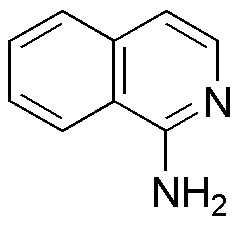1-Aminoisoquinoline is widely utilized in research focused on:
- Pharmaceutical Development: This compound serves as a key intermediate in the synthesis of various pharmaceuticals, particularly those targeting neurological disorders. Its unique structure allows for the development of drugs with enhanced efficacy.
- Fluorescent Probes: Researchers use 1-aminoisoquinoline in creating fluorescent probes for biological imaging. These probes help in visualizing cellular processes, making it easier to study disease mechanisms.
- Catalysis: In organic synthesis, this compound acts as a catalyst in various reactions, improving reaction rates and yields. Its application in catalysis can lead to more efficient production processes in the chemical industry.
- Material Science: It is employed in the development of advanced materials, including polymers and coatings, which exhibit improved thermal and mechanical properties. This makes it valuable in industries such as automotive and aerospace.
- Research in Organic Chemistry: 1-Aminoisoquinoline is a versatile building block for synthesizing complex organic molecules, facilitating research in medicinal chemistry and drug discovery.
General Information
Properties
Safety and Regulations
Applications
1-Aminoisoquinoline is widely utilized in research focused on:
- Pharmaceutical Development: This compound serves as a key intermediate in the synthesis of various pharmaceuticals, particularly those targeting neurological disorders. Its unique structure allows for the development of drugs with enhanced efficacy.
- Fluorescent Probes: Researchers use 1-aminoisoquinoline in creating fluorescent probes for biological imaging. These probes help in visualizing cellular processes, making it easier to study disease mechanisms.
- Catalysis: In organic synthesis, this compound acts as a catalyst in various reactions, improving reaction rates and yields. Its application in catalysis can lead to more efficient production processes in the chemical industry.
- Material Science: It is employed in the development of advanced materials, including polymers and coatings, which exhibit improved thermal and mechanical properties. This makes it valuable in industries such as automotive and aerospace.
- Research in Organic Chemistry: 1-Aminoisoquinoline is a versatile building block for synthesizing complex organic molecules, facilitating research in medicinal chemistry and drug discovery.
Documents
Safety Data Sheets (SDS)
The SDS provides comprehensive safety information on handling, storage, and disposal of the product.
Product Specification (PS)
The PS provides a comprehensive breakdown of the product’s properties, including chemical composition, physical state, purity, and storage requirements. It also details acceptable quality ranges and the product's intended applications.
Certificates of Analysis (COA)
Search for Certificates of Analysis (COA) by entering the products Lot Number. Lot and Batch Numbers can be found on a product’s label following the words ‘Lot’ or ‘Batch’.
*Catalog Number
*Lot Number
Certificates Of Origin (COO)
This COO confirms the country where the product was manufactured, and also details the materials and components used in it and whether it is derived from natural, synthetic, or other specific sources. This certificate may be required for customs, trade, and regulatory compliance.
*Catalog Number
*Lot Number
Safety Data Sheets (SDS)
The SDS provides comprehensive safety information on handling, storage, and disposal of the product.
DownloadProduct Specification (PS)
The PS provides a comprehensive breakdown of the product’s properties, including chemical composition, physical state, purity, and storage requirements. It also details acceptable quality ranges and the product's intended applications.
DownloadCertificates of Analysis (COA)
Search for Certificates of Analysis (COA) by entering the products Lot Number. Lot and Batch Numbers can be found on a product’s label following the words ‘Lot’ or ‘Batch’.
*Catalog Number
*Lot Number
Certificates Of Origin (COO)
This COO confirms the country where the product was manufactured, and also details the materials and components used in it and whether it is derived from natural, synthetic, or other specific sources. This certificate may be required for customs, trade, and regulatory compliance.


